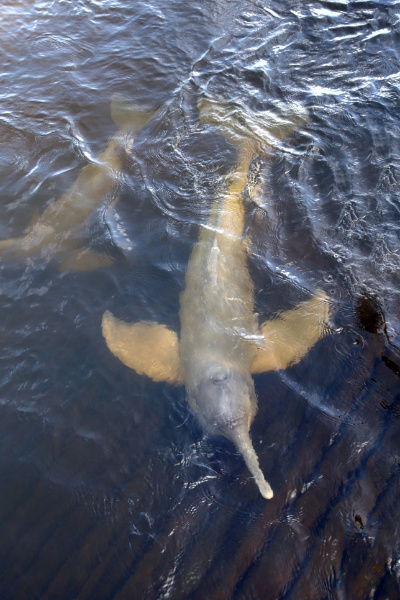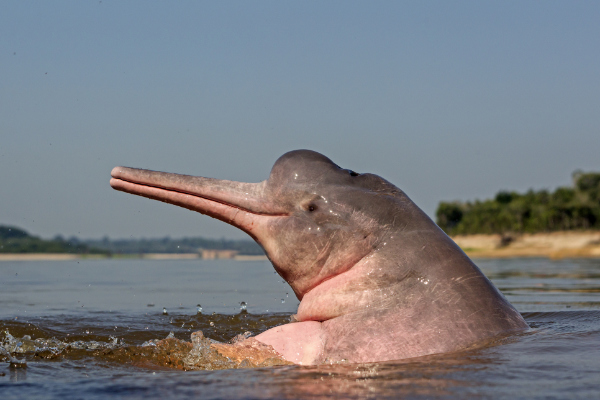Overshadowed by their oceanic cousins, it’s time the pink river dolphin had a moment in the spotlight. These mysterious mammals are found in South America and belong to the same family (cetaceans) as whales and porpoises. Ready to learn more about these amazing aquatic creatures? Read on to discover our top ten pink river dolphin facts…
1. Freshwater Habitats
2. Puzzlingly Pink
3. Measure Up
4. Different Species
5. Bulging Melons
6. Diverse Diet
7. Endangered Species
8. Amazing Adaptations
9. Fascinating Folklore
10. Behavioural Patterns
1.
Freshwater Habitats
First on our list of pink river dolphin facts is one about their habitats. Also known as boto, or Amazon river dolphins, the species are (surprise, surprise) mainly found in the Amazon River basin but they also inhabit the Orinoco basin and Madeira River, too. You’ll only find these pink cetaceans in freshwaters snaking their way through Bolivia, Brazil, Colombia, Ecuador, Peru, Guyana and Venezuela.
2.
Puzzlingly Pink
Now for the question on everyone’s minds: why are they pink? Well, nobody is entirely sure. Males are pinker than females, and calves begin dark grey, turning greyish pink as they grow older. Ranging from pastel and peach to mottled grey, there are many theories as to why these dolphins are flushed pink. It’s believed the hue varies with water conditions, between geographic areas and abrasions to the skin’s surface. The cetaceans were pink long before the release of the Barbie movie, so at least we can rule out that explanation…
3.
Measure Up
Here’s another pink river dolphin fact to pique your interest: unlike their other cetacean counterparts (including their oceanic cousins) male Amazon river dolphins are larger than females. Males measure, on average, 7.6 ft long and weigh around 150 kg, whereas females average 6.6 ft and 100 kg. Overall, the pink river dolphin is slightly smaller than the oceanic variety but is the largest out of the river dolphins (you can’t win 'em all).

4.
Different Species
Did you know that pink river dolphins aren’t the only river-dwelling cetaceans in the Amazon? They share their vast freshwater habitats with two other types of river dolphins, although it’s believed that the pink river dolphins are the most intelligent of the lot. With a brain capacity 40% larger than humans, they are not to be underestimated.
5.
Bulging Melons
Next up on the list of pink river dolphin facts concern their bulbous foreheads, otherwise known as ‘melons’. Yes, melons. This bulge plays a very important role, housing the dolphin’s echolocation system. Used to locate their prey, they emit a series of high-pitched clicks and listen for echoes bouncing off potential prey. They’re also known to communicate via whistling (although don’t expect it to sound tuneful to us).
6.
Diverse Diet
Pink river dolphins enjoy a varied carnivorous diet, which changes with the seasons. While murky river water might not be the easiest place to spot their next meal, these crafty creatures have learnt to adapt. Rather than relying on sight, river dolphins use their long, thin snouts to rummage through the riverbeds for food, with hairs on the end of their snouts aiding the search. Feasting on over 50 species of fish, shrimps, crabs and even small turtles, pink river dolphins eat approximately 2.5% of their body weight each day.
7.
Endangered Species
The most sobering on our list of pink river dolphin facts is their endangered species status. They’re one of the most endangered in the cetacean family, in fact, with human activity posing the greatest threat to their survival. As the Amazon basin is destroyed for human gain, the dolphins face a loss of habitat and fewer food sources. They can get caught in fishing nets and even be hunted by fishermen, while rising levels of mercury in the river – due to deposits from (often illegal) gold mining – have also increased deaths.

8.
Amazing Adaptations
Unlike other dolphin species, pink river dolphins can turn their heads 90 degrees (thanks to their unfused cervical vertebrae). Along with large, paddle-like flippers which move in different directions in a circular movement, these adaptations allow them to survive during river floods. Although they’re not speedy swimmers (they average between five and eight mph), pink river dolphins are able to skilfully manoeuvre around obstacles like trees thanks to their flexibility and built-in paddles.
9.
Fascinating Folklore
Did you know that pink river dolphins are shrouded in mythology? In traditional Amazonian folklore, it's believed the dolphins adopt a human form and stalk the rainforest at night, seducing local women. Other local lore claims that making eye contact with a pink river dolphin will damn you to a lifetime of terrible nightmares. Some also believe them to be magical guardians of an underwater realm. Folklore aside, there’s no denying that the pink river dolphin is one enigmatic aquatic creature.
10.
Behavioural Patterns
It’s time to round off our list of pink river dolphin facts with a quick lesson on their behavioural patterns. The dolphins are solitary creatures, who are active during the day and rest at night. Although they are sometimes found in small groups, these cetaceans are not as sociable as their ocean-dwelling counterparts, who travel in tightly-knit pods. Nonetheless, they are curious and charming mammals who will approach boats and be playful.
Written by Hannah Whitehall
